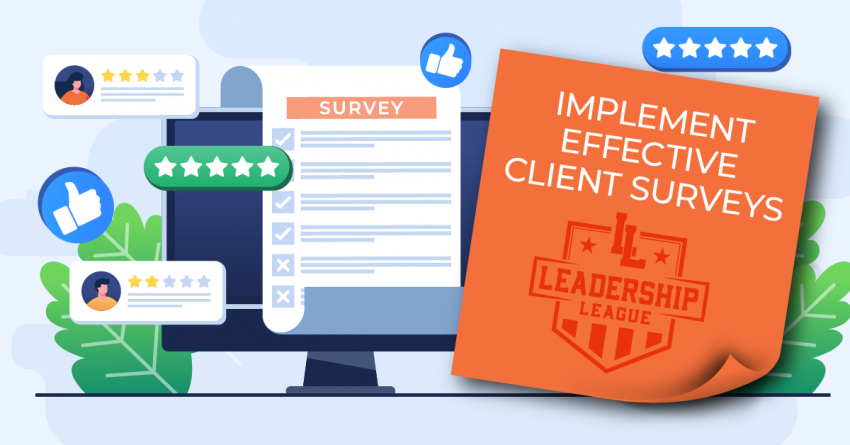Maximizing Client Satisfaction in AEC: The Power of Strategic Client Care Surveys
For most businesses in the Architecture, Engineering, and Construction (AEC) industry, 80% of our work comes from 20% of our clients. This reality, known as the Pareto Principle, tells us that exceptional client care is crucial for a flourishing business. When clients are more than just satisfied—when they become champions of your firm—the path to project success and future opportunities becomes smoother and infinitely more rewarding. Ensuring the happiness and loyalty of this crucial 20% isn't just good practice; it's the lifeblood of your business's growth and reputation.
But how do you know your client is happy? The easiest way is through a Client Care Survey.
Client Care Surveys encompass everything from soft check-ins to devoted interviews, and they’re your main tool to measure client satisfaction. After measurement, they help everyone know how to better care for the current client, a critical leg-up during the project process. There’s more to them than meets the eye, however, and—like with all team sports—it’s best to approach them with a plan.
What Are You Looking to Learn?
When it comes to conducting surveys during a project, which is our focus here, every survey should be looking to measure satisfaction. That satisfaction encompasses three main aspects of the project:
- Results. Is your client satisfied with the results and timeline thus far?
- Process. Does your client find the process smooth and enjoyable?
- People. Does your client find your team friendly, responsive, and expert?
Knowing what your team needs to know before you prepare for a Client Care Survey will help with your focus and organization, and therefore your ability to deliver on any feedback.
How Will You Contact Your Client?
Survey method will differ from client to client, and you should go in knowing which members of the client you wish to receive feedback from. There are three steps for approach:
- Who will conduct the survey?
- It should be someone working directly on the project.
- The roles of the team member and the client member should be roughly equal—a manager should reach out to a manager, and so on.
- It should be someone working directly on the project.
- How will you get in contact with your client?
- Whether it’s email, text, a call, or otherwise, different clients prefer different methods of reaching out, and you should know which will be most effective.
- Whether it’s email, text, a call, or otherwise, different clients prefer different methods of reaching out, and you should know which will be most effective.
- How often will you check in on your client?
- As Client Care Surveys take time, it’s important to consider the worth on both your and your client’s end. Conduct a Client Care Survey as appropriate and at deliberate intervals to ensure a flexible thoroughness.
- You might consider these hard and flexible intervals:
- A formal check-in yearly
- A semi-formal check-in every six months
- Semi-formal to formal check-ins at key points in the project
- Soft check-ins as necessary
- A formal check-in yearly
- As Client Care Surveys take time, it’s important to consider the worth on both your and your client’s end. Conduct a Client Care Survey as appropriate and at deliberate intervals to ensure a flexible thoroughness.
Forms of Client Care Survey
There are two main forms of Client Care Survey: the interview and survey proper. Interviews are conducted between two people, whereas surveys are conducted through a different medium—usually digitally. Both can be used during the project process, though you will likely find digital surveys to be most useful shortly after a project is done.
Both forms require you to come in prepared with thoughtful questions that account for the goals of your check-in. What do you wish to learn from this particular person? Remember that your Client Care Surveys are about your client’s experience—not your own.
|
Interviews |
Surveys | |
|---|---|---|
|
+ Allow the team to directly connect with the client + Easier to personalize the experience - Rely on the organization of the individual conducting the interview These are best conducted at the client’s location and convenience, though they can be taken over call or video. It is crucial to set a tone of friendliness, acceptance, and willingness to listen. At the end of your interview, you should ask if your client has anything else they wish to tell you, in case there is anything your questions have missed. Always take notes during the interview. After the interview, take the following steps:
|
+ Brief, professional, and official + Responses are direct from the client and have no hearsay concerns - Lacks flexibility - Lacks direct connection to client Formulate your digital surveys with intention and always test them out beforehand, tweaking your questions as needed. Refine your survey to deliver its most compelling questions. It is better to have fewer valuable questions than several weak ones. Consider the following while creating your questions:
|
Keeping Your Efforts Relevant
Client Care Surveys take a lot of time and effort in order for them to be valuable—and they are. With project-specific Client Care Surveys especially, however, the information has a shelf life. Quick and efficient follow-ups are crucial and involve at least three things:
- Submitting a report to fellow principals and leadership
- Make sure everyone sees the crucial takeaways from the interview—both critiques and praise
- Make sure everyone sees the crucial takeaways from the interview—both critiques and praise
- Contacting relevant people to deliver feedback
- Follow through with anyone who the interview concerns; be tactful with any needs for improvement
- Follow through with anyone who the interview concerns; be tactful with any needs for improvement
- Address the issues
- Don’t just talk about them; make a plan and always return to the client to show proof of effort
Client Care Surveys, at their core, show a responsiveness to the client that elevates their experience during the project. They prevent any issues from gaining too much ground and allow a firm to lean into their strengths with a client, increasing trust and retention. Like a team huddle in the middle of a game, Client Care Surveys ensure that your team can obtain the goal that is project success and client satisfaction.
This article draws from MARKENDIUM Domain 6.






